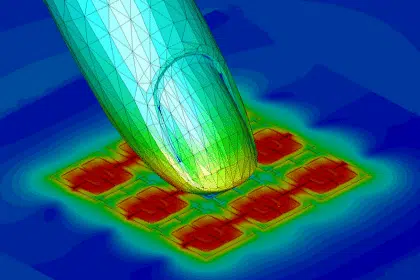Key Benefits of Electromagnetic Simulation

Design Confidence
Perform what-if-analysis to understand your product and the requirements’ margin before receiving the first prototype. When you know your product – it’s strengths and weaknesses – you know when and where to focus your energy to make sure the product meets your requirement and time plan.

Reduce Costs
Efficient workflows and co-operation within the R&D team in combination with optimized product performance reduces cost and time-to-market. Import parametrized models, instantly reflect design changes in your simulation model by creating a bidirectional link between CAD and simulation.

Drive Innovation
Simulation helps you to investigate new ideas, and explore options without manufacturing a prototype. Use simulation to decrease the likelihood of discovering errors and suboptimal components late. Equip your teams with valuable data that bridges the gap between experimentation and learning.

Maximize R&D Utilization
Make the most of R&D by implementing collaborative simulation throughout product development. Simulation allows you to evaluate your design as soon as your model’s complete. Simulations also work as an important troubleshooting tool, allowing you to perform quick assessments of product changes.
What Can You Do With Electromagnetic Simulation?
Antennas
Design and optimize components ranging from printed PCBs to large arrays or reflector antennas.
Electromagnetic Compatibility (EMC)
Ensure compliance with regulations for conducted and radiated emissions in the early design stages.
Circuits & 3D
Schematic design tool for circuit and system level simulations based on analytical models.
Microwaves & RF
Model and simulate filters ranging from planar filters to cavity and waveguide filters.
Cable Harnesses
Fast and accurate investigation of cables in complex EM environments.
Printed Circuit Boards
Identify coupling paths for Signal Integrity (SI), Power Integrity (PI) and Electromagnetic compatibility (EMC).
Lightning Strikes
Electrostatic solver for optimizing electromagnetic performance of products such aircraft and wind turbines.
Bioelectromagnetics
Ensure compliance to safety regulations for medical devices, electric vehicles, and more.
Transformers & Power Equipment
Increase the efficiency of power generators with accurate calculations of transformer efficiencies.
Magnets
Powerful tool for the development of magnetic components in MRI machines, electrical machines, and particle accelerators.
Electrical Motors & Generators
Accurately model electromagnetic fields including axial and radial flux topologies.
High Voltage Devices
Analyze the operating states of high voltage lines and cables transmissions.
Linear Actuators
Capture the motion-induced effects of axis movements while coupling circuit simulation with FEA.
Charged Particles
Solve Maxwell’s equations using FEM to find the interaction of charged particles.
How Are Companies Using Electromagnetic Simulation?
Many design issues and requirements result in several product tests during development, both digitally and physically. Typical measures of the degree of amplification, frequency response, distortion, internal noise, current drain, telecoil sensitivity, directionality, automated gain control, antenna performance, and electromagnetic compatibility are among the performance statistics of importance for hearing aids.
WSA offers a variety of physical examinations in their own labs. These facilities are filled with drop-testing labs, fast cameras, acoustics labs, and more.
Stefan Menzl, Chief R&D Officer | WSA













